Babes in the Wood
Babes in the Wood is a traditional English children's tale, as well as a popular pantomime subject. It has also been the name of some other unrelated works. The expression has passed into common language, referring to inexperienced innocents entering unawares into any potentially dangerous or hostile situation. A number of child murder cases have been referred to in the media as the Babes in the Wood murders.
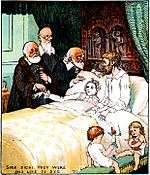 The parents: so sick they were apt to die |
 "Now, brother", said the dying man, "look to my children dear" |
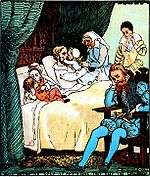 With lips as cold as any stone, they kiss the children small |
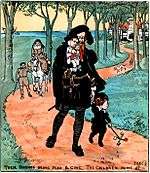 The parents being dead and gone, the children home he takes |
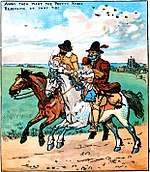 Away then went those pretty babes, rejoicing at that tide |
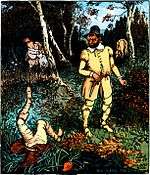 And he that was of mildest mood, did slaye the other there |
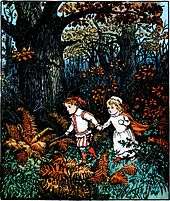 These pretty babes, with hand in hand, went wandering up and down |
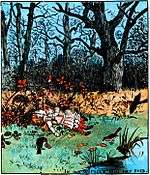 In one another’s arms they died |
Traditional tale
The traditional children's tale is of two children abandoned in a wood, who die and are covered with leaves by robins.
It was first published as an anonymous broadside ballad by Thomas Millington in Norwich in 1595 with the title "The Norfolk gent his will and Testament and howe he Commytted the keepinge of his Children to his own brother whoe delte most wickedly with them and howe God plagued him for it".[1] The tale has been reworked in many forms; it frequently appears attributed as a Mother Goose rhyme. Starting around 1840, The Babes in the Wood; or, the Norfolk Tragedy, was included in The Ingoldsby Legends, an exceptionally popular miscellany of folklore and poetry, reprinted throughout the nineteenth century. The tale's endnote alludes to Bloomfield's [sic] History of the County of Norfolk, but that work's Wayland section does not mention it. The anonymous ballad was also illustrated by Randolph Caldecott in a book published in 1879.
The story tells of two small children left in the care of an uncle and aunt after their parents' death. The uncle gives the children to ruffians to be killed, in order to acquire their inheritance, telling his wife they are being sent to London for their upbringing. The murderers fall out, and the milder of the two kills the other. He tells the children he will return with provisions, but they do not see him again. The children, wandering alone in the woods, die, and are covered by leaves by the birds. Like many morality tales, the story continues with a description of the retribution befalling the uncle. In sanitized versions, the children are bodily taken to Heaven. The story ends with a warning to those who have to take care of orphans and others' children not to inflict God's wrath upon themselves.
The Walt Disney Company re-worked this tale for their 1932 short animated film Babes in the Woods, incorporating some material from Hansel and Gretel by the Brothers Grimm, and adding a village of friendly elves (a feature not traditionally present in either tale) and a happy ending.
The story is also used as a basis for pantomimes. However, for various reasons including both the brevity of the original and the target pantomime audience of young children, modern pantomimes by this name usually combine this story with parts of the modern Robin Hood story (employing the supporting characters from it, such as Maid Marian, rather than Robin himself) to lengthen it.
Folklore
Folklore has it that the events told in Babes in the Wood originally happened in Wayland Wood in Norfolk, England. It is said that the uncle lived at the nearby Griston Hall. The ghosts of the murdered children are said to haunt Wayland Wood.[2] The village signs at Griston and nearby Watton depict the story. In the folklore version, the uncle resents the task and pays two men to take the children into the woods and kill them. Finding themselves unable to go through with the act, the criminals abandon the children in the wood where, unable to fend for themselves, they eventually die.
Notes
- Opie, I and Opie, P.: The Oxford Book of Narrative Verse, Oxford University Press, 1983, page 387.
- "Norfolk Folk Tales – Legends said to have originated in Norfolk". Visit Breckland. Breckland District Council. Archived from the original on 4 March 2007.
References
- "Babes in the Wood". Norfolk Myths. Archived from the original on 4 February 2005. Retrieved 14 March 2005.
- "Babes in the Wood Lyrics". Mama Lisa's World Song Lyrics Around the World. Retrieved 14 March 2005.
- "The Babes in the Wood". The Phrase Finder. Archived from the original on 27 March 2005. Retrieved 14 March 2005. This includes the text of the Thomas Millington ballad.
- "Babes in the Wood". Nursery Rhymes. Archived from the original on 15 March 2005. Retrieved 14 March 2005. This is the Mother Goose rhyme.
- "Babes in the Wood". Tom Wilkins, The Encyclopaedia of Disney Animated Shorts. Archived from the original on 22 February 2007. Retrieved 14 March 2005.
External links
| Wikimedia Commons has media related to Babes in the Wood. |
| Wikiquote has quotations related to: Babes in the Wood |
| Wikisource has original text related to this article: |
- The Babes in the Wood PDF with Lesson Plans
- The Project Gutenberg EBook of The Babes in the Wood, with illustrations by R. Caldecott
- The Babes in the Wood The Babes in the Wood song lyrics with illustrations
- The history of English pantomime
- History of the story and its descendent versions
- The Abandoned Children of Wailing Wood Animated and narrated version of the legend
- Multiple fully online versions of Babes in the Wood from the University of Florida's Baldwin Library of Historical Children's Literature
- Alternative origin for the Babes in the Wood Legend Agecroft Hall, near Prestwich, England)
- babesinthewoods.skyrock.com (in French)